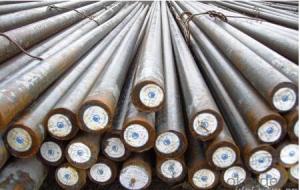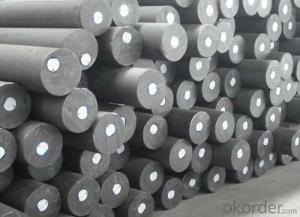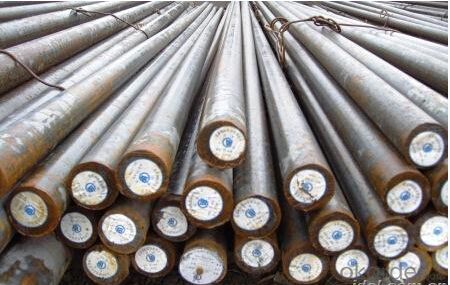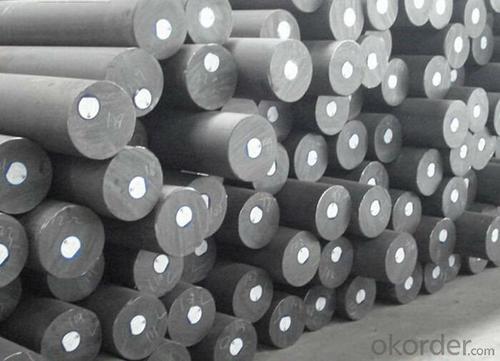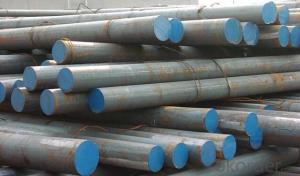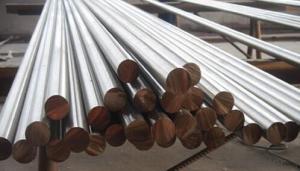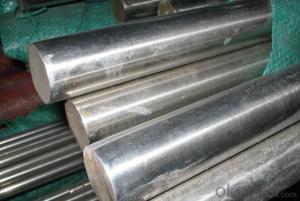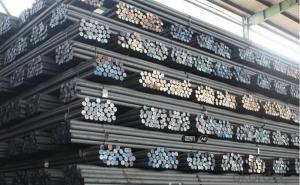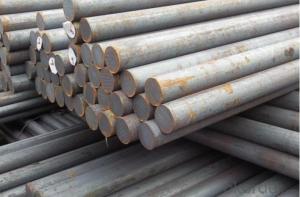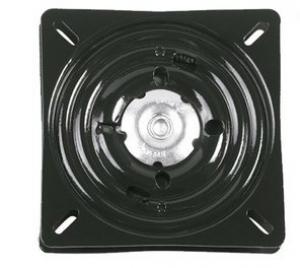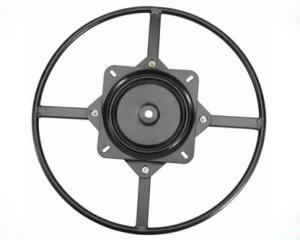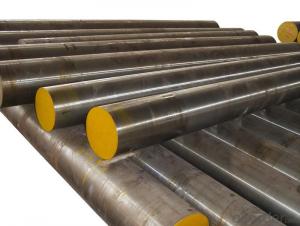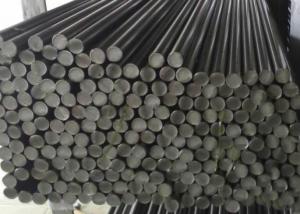Grade 30MnVS6 CNBM Forged Alloy Steel Round Bar
- Loading Port:
- Shanghai
- Payment Terms:
- TT or LC
- Min Order Qty:
- 3 m.t.
- Supply Capability:
- 10000 m.t./month
OKorder Service Pledge
OKorder Financial Service
You Might Also Like
Specification
Specification:
Standard:
Our products meet Chinese GB, Japanese JIS, US ASTM, UK BS, EU DIN standards and so on.
Round bar:
Diameter : 1mm-2000mm
Chemical Composition:
C | Si | Mn | P | S | Cr | Mo | N | V |
0,26 - 0,33 | 0,15 - 0,80 | 1,20 - 1,60 | max. 0,025 | 0,02 - 0,06 | max. 0,30 | max. 0,08 | 0,01 - 0,02 | 0,08 - 0,20 |
Usage and Applications:
Mainly used in automobile manufacturing for the part of crankshaft, linkage,steering knuckle, wheel hub, door butt and semi-axle shaft sleeve..etd.
Packaging & Delivery:
Packaging Detail: Standard seaworthy packing or as customer required; all goods are packed in bundle with steel strips and shipped by break bulk vessel or container
Delivery Detail: 45 days
Production Flow:
hot forging/hot rolling + annealing/normalizing + tempering/quenching + tempering/any conditions based on the customer's requirement

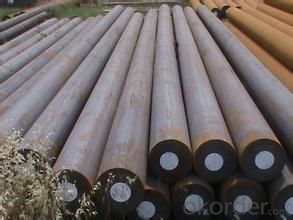
Quality Assurance:
1. We will strictly inspect our production that we sold according to the customer’s request.
2. Our steel reaches international quality standards.
3. Quality should be in conformity with the specification of the manufacturer. Quantity and packing conditions should be in conformity with the term in the contract.
4. Should the packing found damaged, the buyer has the right to claim to the seller
"Steel alloy in addition to iron, carbon, the addition of other alloy elements, called alloy steel. In the ordinary carbon steel on the basis of adding one or more moderate alloy and iron carbon alloy. The special properties of high strength, high toughness, wear resistance, corrosion resistance, low temperature resistance, high temperature resistance and non magnetism can be obtained according to the different adding elements.
Many kinds of alloy steel, usually alloy element content how many points for low alloy (content of less than 5%) and in (the content of 5% ~ 10%) steel, high alloy steel (content > 10%); according to the quality points according to the high-quality alloy steel, the characteristics of alloy steel; according to the characteristics and uses and alloy structure steel, stainless steel, acid resistant steel, wear-resistant steel, heat-resistant steel, alloy tool steel, rolling bearing steel, alloy spring steel and special properties of steel, such as soft magnetic, permanent magnetic steel, non-magnetic, etc..
In the process of steel making, manganese is a good agent for the removal of sulfur and sulfur, and manganese in steel is 0.50% to 0.30. In plain carbon steel to join more than 0.70% even manganese steel, than the average amount of steel of steel not only enough toughness and have higher strength and hardness, improve the quenching of steel, steel to improve the performance of thermal processing, such as 16Mn steel A3 than the yield point is up to 40% of. Wear resistance high manganese steel 11 - 14%, for the excavator bucket, ball mill liner. The increase of manganese content, reduce the corrosion resistance of steel, reduce the welding performance."
- Q: What are the different oil and gas grades of special steel?
- There are several different oil and gas grades of special steel, including but not limited to API 5CT, API 5L, and ASTM A106. These grades are specifically designed to meet the requirements and demands of the oil and gas industry, ensuring high strength, corrosion resistance, and durability in harsh environments.
- Q: How does special steel contribute to the automotive aftermarket industry?
- Special steel plays a significant role in the automotive aftermarket industry by offering various advantages that contribute to the overall performance, durability, and safety of vehicles. Firstly, special steel is known for its exceptional strength and durability. This property allows automotive manufacturers and aftermarket suppliers to develop high-performance components and parts that can withstand extreme conditions and heavy usage. Components such as engine parts, suspension systems, and chassis components benefit from the superior strength of special steel, ensuring their longevity and reliability. Additionally, special steel offers excellent corrosion resistance, which is crucial for automotive components exposed to various weather conditions and road environments. By using corrosion-resistant steel, aftermarket suppliers can produce parts that are less prone to rust and degradation, ultimately enhancing the lifespan of vehicles and reducing the need for frequent replacements. Furthermore, special steel enables the production of lightweight components without compromising on strength. With the increasing demand for fuel efficiency and reduced emissions, lightweight materials are highly sought after in the automotive industry. By utilizing special steel, aftermarket suppliers can create lightweight parts that contribute to improved fuel economy and overall performance of vehicles. Moreover, special steel's versatility allows for the development of complex and intricate components, contributing to advancements in vehicle technology. From precision-engineered gears and shafts to specialized parts for electric vehicles, special steel can be tailored to meet specific automotive requirements, supporting the industry's continuous innovation. Lastly, special steel offers cost-effectiveness in the automotive aftermarket industry. Although the initial cost of special steel might be higher than conventional steel, its durability and longevity result in reduced maintenance and replacement costs over time. This benefit is particularly significant for aftermarket suppliers and vehicle owners, as it helps minimize expenses and ensures a higher return on investment. In conclusion, special steel plays a vital role in the automotive aftermarket industry by providing strength, durability, corrosion resistance, lightweight properties, versatility, and cost-effectiveness. These qualities contribute to the overall performance, safety, and longevity of vehicles, making special steel a crucial material in the development of high-quality aftermarket components and parts.
- Q: What are the different types of corrosion-resistant steel?
- There are several different types of corrosion-resistant steel, including stainless steel, galvanized steel, weathering steel, and nickel alloy steel.
- Q: What are the limitations of using special steel in electrical applications?
- There are several limitations to using special steel in electrical applications. Firstly, special steel can be more expensive compared to other materials commonly used in electrical applications, such as copper or aluminum. This can make it less cost-effective, especially for large-scale projects. Another limitation is that special steel has a relatively high electrical resistivity compared to copper or aluminum. This means that it is less efficient in conducting electricity, leading to higher energy losses and lower overall efficiency in electrical systems. This can be particularly important in applications where energy efficiency is a priority, such as in power generation or transmission. Additionally, special steel is generally less malleable and ductile compared to other materials like copper. This makes it less suitable for applications that require shaping or forming, as it can be more difficult to work with and may require more complex manufacturing processes. Furthermore, special steel is more prone to corrosion compared to materials like copper or aluminum. This can be a significant limitation in electrical applications, particularly in environments with high humidity or exposure to moisture. Corrosion can lead to degradation of the steel's electrical properties, reduce its lifespan, and increase maintenance and replacement costs. Lastly, special steel may not be as readily available or easily sourced as other materials commonly used in electrical applications. This can pose challenges in terms of availability, lead times, and potential supply chain disruptions, which may impact project timelines and overall productivity.
- Q: What are the requirements for special steel used in surgical instruments?
- The requirements for special steel used in surgical instruments are quite stringent due to the critical nature of their application in medical procedures. First and foremost, the steel must have excellent corrosion resistance to withstand the repeated exposure to body fluids and chemicals used in sterilization processes. This ensures that the instruments remain durable, hygienic, and safe for use. Another essential requirement is high strength and hardness, as surgical instruments must be able to withstand the forces exerted during procedures without bending, breaking, or losing their sharpness. Additionally, the steel should possess excellent wear resistance to maintain its cutting edge for an extended period, reducing the need for frequent sharpening or replacement. Biocompatibility is another crucial factor for surgical instruments. The steel should not cause any adverse reactions when in contact with living tissue or fluids, minimizing the risk of infection or complications for patients. This requires the absence of harmful elements or impurities that may trigger allergic responses or toxicity. Furthermore, the steel used in surgical instruments must be highly sterilizable. It should be capable of withstanding high temperatures during autoclaving or other sterilization methods without undergoing significant changes in its physical or mechanical properties. Lastly, the steel should be easily workable, allowing for precision manufacturing processes such as forging, machining, and polishing to create intricate instrument designs. This ensures that surgical instruments have the necessary shape, size, and surface finish required to perform specific tasks effectively. Overall, the requirements for special steel used in surgical instruments encompass corrosion resistance, strength, hardness, wear resistance, biocompatibility, sterilizability, and workability to ensure the instruments meet the demanding standards of the medical field.
- Q: What are the different magnetic grades of special steel?
- Various applications commonly utilize different magnetic grades of special steel. Some well-known magnetic grades include: 1. Soft Magnetic Materials: These special steel grades possess high magnetic permeability and low coercivity. They are ideal for applications requiring strong magnetic induction, such as transformers, electric motors, and magnetic cores for electrical devices. 2. Martensitic Stainless Steels: In their hardened state, these special steel grades exhibit a high magnetic permeability. They are commonly employed in cutlery, tools, and specific automotive components. 3. Ferritic Stainless Steels: Although their magnetic permeability is lower compared to martensitic stainless steels, these special steel grades are still magnetic. They find application in automotive exhaust systems, decorative trim, and appliances. 4. Duplex Stainless Steels: These special steel grades have a mixed microstructure of austenite and ferrite, resulting in a magnetic response. They are renowned for their exceptional corrosion resistance and are utilized in chemical processing equipment and offshore oil and gas platforms, where both strength and corrosion resistance are crucial. 5. Austenitic Stainless Steels: In their annealed state, these special steel grades are non-magnetic. However, slight magnetism can be observed when they undergo cold working or contain specific alloying elements. Austenitic stainless steels are widely used in food processing equipment, architectural structures, and medical devices. It is important to remember that the presence or absence of magnetism in special steel grades can vary depending on factors such as composition, heat treatment, and processing. Therefore, it is essential to consider the specific requirements of an application when selecting the appropriate magnetic grade of special steel.
- Q: How is special steel tested for quality and performance?
- Special steel is tested for quality and performance using a variety of methods, including visual inspection, mechanical testing, and chemical analysis. Visual inspection involves examining the steel for any surface defects or abnormalities. Mechanical testing involves subjecting the steel to various physical stress tests to assess its strength, hardness, toughness, and other mechanical properties. Chemical analysis is performed to check the composition of the steel, ensuring it meets the required standards and specifications. These comprehensive testing procedures are essential to guarantee the quality and performance of special steel in various applications.
- Q: What are the different impact-resistant grades of special steel?
- There are various impact-resistant grades of special steel, including AR400, AR500, AR550, and AR600. These grades are specifically designed to withstand high levels of impact and abrasion, making them suitable for applications such as construction equipment, industrial machinery, and mining tools.
- Q: What are the challenges in heat treatment of special steel?
- Some challenges in the heat treatment of special steel include achieving the desired hardness and strength without compromising other properties, such as toughness and corrosion resistance. Special steels often have complex compositions, which can make it difficult to accurately control the heat treatment process. Additionally, heat treatment of special steel can be time-consuming and costly due to the need for precise temperature and time control, as well as the potential for distortion or cracking during the heat treatment process.
- Q: What are the different methods for improving the wear resistance of special steel?
- There are several methods for improving the wear resistance of special steel. Some common techniques include heat treatment processes such as quenching and tempering, which can increase the hardness and toughness of the steel. Another method is surface coating, where a thin layer of a wear-resistant material like carbides or ceramics is applied to the steel surface. Additionally, alloying the steel with elements like chromium, vanadium, or tungsten can enhance its wear resistance properties. Finally, precision machining and grinding can be used to achieve a smoother surface finish, reducing friction and wear.
Send your message to us
Grade 30MnVS6 CNBM Forged Alloy Steel Round Bar
- Loading Port:
- Shanghai
- Payment Terms:
- TT or LC
- Min Order Qty:
- 3 m.t.
- Supply Capability:
- 10000 m.t./month
OKorder Service Pledge
OKorder Financial Service
Similar products
Hot products
Hot Searches
Related keywords
